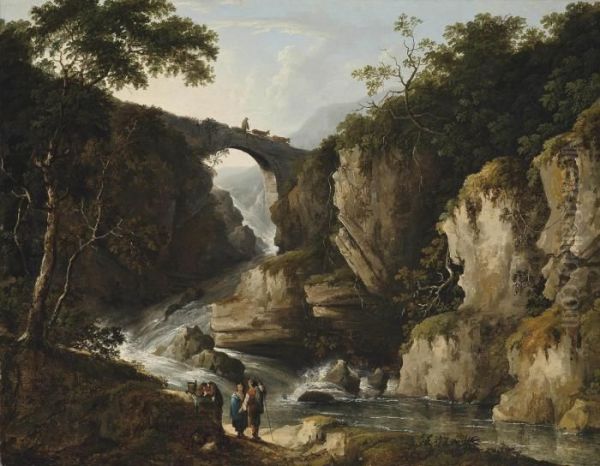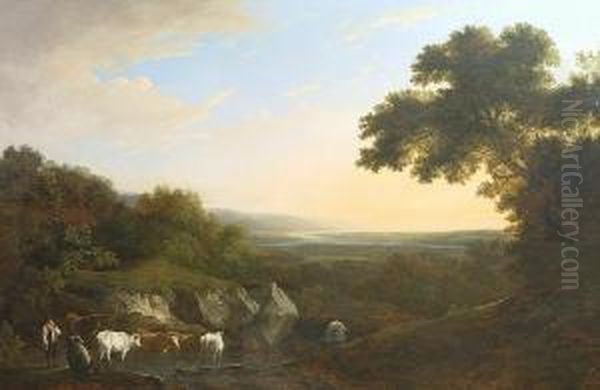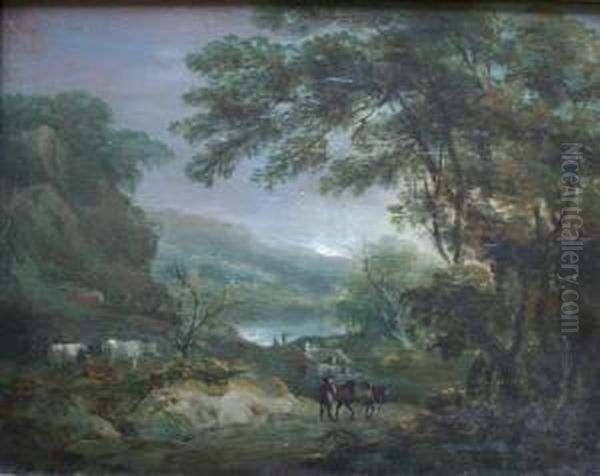Benjamin Barker of Bath (1776–1838) stands as a noteworthy figure in the rich tapestry of British landscape painting during the late 18th and early 19th centuries. While perhaps not possessing the towering international fame of contemporaries like J.M.W. Turner or John Constable, Barker carved out a significant career, admired for his sensitive depictions of the English and Welsh countryside, primarily in oils and watercolours. His life, marked by early adversity and a persistent dedication to his craft, offers a fascinating glimpse into the world of a provincial artist navigating the burgeoning art market and evolving tastes of the period. He was intrinsically linked to the artistic milieu of Bath, a fashionable spa town that also nurtured other artistic talents, and his story is intertwined with that of his more famous elder brother, Thomas Barker, often referred to as "Barker of Bath."
Early Life and Formative Influences
Born in 1776 in Pontypool, Monmouthshire, Wales, though always associated with Bath where his family soon moved, Benjamin Barker's early years were far from idyllic. His father, Benjamin Barker Sr., was an amateur artist and a man described as once affluent but later having "sunk into idleness and poverty." This precarious financial situation undoubtedly cast a shadow over young Benjamin's childhood. A particularly traumatic incident from this period was a near-drowning in a canal near Bristol, an event that likely left a lasting psychological mark.
Despite these challenges, an artistic inclination was present in the family. Benjamin and his elder brother, Thomas Barker (1769-1847), who would go on to achieve considerable fame, began to explore their artistic talents together. Their early efforts involved creating small copies of Old Master paintings. This practice was common for aspiring artists of the time, serving as a vital method of self-education in composition, colour, and technique, especially when formal art academy training was not readily accessible. Artists like Sir Joshua Reynolds, the first president of the Royal Academy, often emphasized the importance of studying the masters.

Their burgeoning talent did not go unnoticed. Living in a humble cottage, the Barker brothers' works attracted the attention of passersby, including a crucial figure in their early careers: Mr. Charles Spackman, a wealthy coachbuilder in Bath. Spackman recognized their potential and became a significant patron, providing support and encouragement that was instrumental in allowing them to pursue their artistic ambitions more seriously. This kind of patronage was vital for artists in an era before widespread public galleries or government arts funding.
The Artistic Milieu of Bath
Bath, in the late 18th and early 19th centuries, was more than just a health resort; it was a vibrant social and cultural hub. Its elegant Georgian architecture, fashionable society, and picturesque surroundings attracted artists and connoisseurs alike. Thomas Gainsborough, one of Britain's greatest portraitists and landscape painters, had spent a formative part of his career in Bath from 1759 to 1774, leaving an indelible mark on the town's artistic landscape. The legacy of Gainsborough, with his fluid brushwork and sympathetic rendering of rustic life and natural scenery, would have been a palpable influence on any aspiring landscape painter in Bath.
It was within this environment that Benjamin Barker honed his skills. While his brother Thomas often focused on rustic genre scenes, sometimes with a sentimental or moralizing tone, Benjamin developed a particular affinity for pure landscape. He worked diligently, mastering both oil painting and the increasingly popular medium of watercolour. The rise of watercolour painting in Britain during this period was significant, with artists like Paul Sandby, often called the "father of English watercolour," and later Thomas Girtin and J.M.W. Turner, elevating it to a major art form.
Development of an Artistic Style
Benjamin Barker's style is characterized by its truthfulness to nature, harmonious colouring, and a gentle, often idyllic, portrayal of the British countryside. His landscapes are typically well-composed, reflecting an understanding of classical landscape principles, yet imbued with a direct observation of natural effects. This led some contemporaries to bestow upon him the laudatory, if perhaps slightly ambitious, title of the "English Poussin." Nicolas Poussin, the 17th-century French classical master, was revered for his ordered, idealized landscapes, often with mythological or biblical figures. While Barker's work was generally more modest in scale and subject, the comparison points to a perceived clarity and compositional strength in his art.

Another significant influence often cited in connection with Barker is the Italian Baroque painter Salvator Rosa. Rosa was famed for his wild, rugged landscapes, often featuring banditti and dramatic, untamed nature – a style that greatly appealed to the burgeoning Romantic sensibility and the taste for the "Sublime" and the "Picturesque." While Barker's scenes are generally more tranquil than Rosa's, elements of the picturesque – an aesthetic category that valued irregularity, ruggedness, and interesting textures in landscape – can certainly be discerned in his work. Thinkers like William Gilpin had popularized the concept of the picturesque, encouraging artists and tourists alike to seek out such qualities in the landscape.
Barker’s engagement with the landscape was direct. He frequently sketched outdoors, capturing the nuances of light and atmosphere, which he would then work up into finished paintings in his studio. His subjects were often drawn from the scenic areas of England and Wales, featuring rolling hills, wooded valleys, meandering rivers, and rustic cottages. Figures, when they appear, are usually integral to the landscape – country folk going about their daily lives, travellers on a path, or anglers by a stream – rather than being the primary focus.
Exhibition Career and Professional Associations
A crucial aspect of any artist's career during this period was public exhibition. Benjamin Barker was a regular contributor to the prestigious annual exhibitions at the Royal Academy of Arts in London, showing his works there from 1800 to 1831. The Royal Academy, founded in 1768 with Sir Joshua Reynolds as its first president, was the premier venue for artists to display their talents and attract patrons. To exhibit there was a mark of professional standing.
Barker also exhibited at other important London venues. He showed works at the British Institution, a society established in 1805 by a group of private connoisseurs to exhibit both Old Masters and the work of living British artists. He continued to exhibit there until 1821. Furthermore, he was associated with the Society of Painters in Water Colours (often known as the Old Watercolour Society), founded in 1804, which played a vital role in promoting watercolour as a serious artistic medium. His involvement with such societies indicates his active participation in the professional art world of his time. Other prominent members of the early watercolour societies included artists like John Varley, David Cox, and Peter De Wint, all of whom contributed to the golden age of British watercolour.
One notable event in his career was a joint exhibition held in Bath with his brother Thomas. This would have provided a valuable opportunity to showcase their collective talents to the local gentry and visiting connoisseurs, further cementing their reputation as the "Barkers of Bath." Such exhibitions were important for sales and for attracting commissions.
Representative Works and Artistic Achievements

While a comprehensive catalogue raisonné might be elusive, several works by Benjamin Barker are known and reside in public and private collections, illustrating his characteristic style. One such example mentioned is "A Wooded Landscape with Figures on a Track, a Bridge Beyond." This title itself evokes the typical elements of his compositions: a carefully structured natural scene, the inclusion of human elements to provide scale and interest, and features like paths and bridges that lead the eye through the landscape. His works often display a pleasing balance between detailed observation of foliage and landforms and a broader, more atmospheric treatment of light and sky.
His proficiency extended beyond original compositions. Like many artists of his time, particularly in their formative years, he produced copies of Old Masters. This practice not only honed his technical skills but also catered to a market for affordable versions of famous works. Additionally, Barker worked as a painting teacher and a picture restorer. These activities provided supplementary income and demonstrate a broad range of artistic and technical expertise. The role of the artist as a teacher was common, with many, like John Sell Cotman of the Norwich School, relying on teaching to support their families.
His landscapes, whether in oil or watercolour, are noted for their "truth and harmonious colouring." He captured the gentle beauty of the British countryside without resorting to overt melodrama, though an appreciation for the picturesque is evident. His focus was often on the everyday rural scene, depicting the quiet dignity of the landscape and its inhabitants. This aligns with a broader trend in British art that saw landscape painting rise from a minor genre to one of great national importance, reflecting a growing appreciation for the native scenery and a sense of national identity.
The Barker Brothers: A Shared and Distinct Legacy
The careers of Benjamin and Thomas Barker are inextricably linked. Thomas, the elder brother, achieved greater contemporary fame, particularly for his large-scale sentimental painting "The Woodman" (based on a poem by William Cowper), which was widely reproduced as an engraving and became immensely popular. He also painted portraits and more ambitious historical and biblical scenes. His house in Bath, Doric House, even featured a fresco painted by him.
While Thomas's output was perhaps more varied and his reputation more widespread, Benjamin carved his own niche as a dedicated landscape specialist. Their joint exhibitions suggest a supportive fraternal relationship, at least professionally. It's interesting to consider how their styles might have complemented or contrasted with each other when seen side-by-side. Both contributed significantly to the artistic reputation of Bath, and their shared surname, often appended with "of Bath," became a recognizable artistic brand.
Later Years and Enduring Legacy
Despite a career marked by consistent output and exhibition, Benjamin Barker's later years were reportedly not prosperous. The art market could be fickle, and tastes changed. The rise of younger, more radical landscape painters like Turner and Constable, who were pushing the boundaries of the genre in new and exciting directions, may have shifted attention away from more traditional practitioners. Artists like John Linnell, a contemporary of Barker, also navigated this changing landscape, often finding success through portraiture and religious subjects alongside landscapes.
Benjamin Barker eventually moved from Bath to Totnes, a town in Devon. It was there that he passed away on March 2nd, 1838, at the age of 62. He was buried in Totnes.
Despite the financial struggles of his later life, Benjamin Barker of Bath left behind a respectable body of work that continues to be appreciated. His paintings can be found in several public collections, including the Bristol Museum & Art Gallery, Eton College, the Government Art Collection, and the National Museum Wales. The Victoria Art Gallery in Bath, naturally, also holds works by both Barker brothers. The naming of "Barker Street" in Bath, with a plaque commemorating "1766–1838" (though his birth year is more commonly cited as 1776), serves as a lasting local tribute to his contribution to the city's artistic heritage.
His influence might be seen as subtle rather than revolutionary. He was a skilled and sensitive interpreter of the British landscape, working within established traditions but bringing his own quiet poetry to his subjects. He represents a generation of artists who consolidated the gains made by earlier pioneers of British landscape art, like Richard Wilson (often considered the father of British landscape painting) and Gainsborough, and who contributed to the rich environment from which the great Romantic landscape painters would emerge. His dedication to capturing the specific character of the English and Welsh countryside places him firmly within the proud tradition of British topographical and picturesque landscape art.
Conclusion
Benjamin Barker of Bath was an artist who, despite early hardships and perhaps being somewhat overshadowed by his elder brother, made a genuine and lasting contribution to British landscape painting. His commitment to his craft, his regular presence at major exhibitions, and his ability to capture the serene beauty of his native land with "truth and harmonious colouring" earned him respect in his own time. While he may not have been an innovator on the scale of a Turner or a Constable, his work provides a valuable window into the artistic tastes and practices of the early 19th century. He remains an important figure for understanding the depth and breadth of the British landscape tradition, a tradition that also included artists like Julius Caesar Ibbetson, known for his rustic scenes, and George Morland, whose depictions of rural life were immensely popular. Benjamin Barker's legacy is that of a skilled, dedicated artist who beautifully chronicled the landscapes he knew and loved.